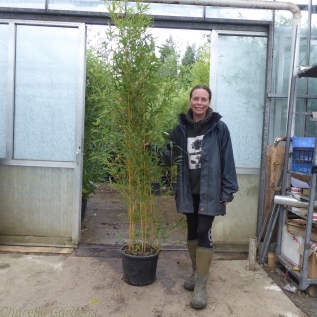Planting Position: Although suitable for a wide range of areas these plants are best suited to a sunny position where the suns rays can help the canes achieve the best colour possible. Although classed as running Bamboo 'Aurea' is a very well behaved Phyllostachys variety, however if you wish to ensure the roots do not spread to surrounding areas it may be advisable to plant using a Rhizome barrier.
Soil: Any free draining damp soil is suitable but away from waterlogged areas.
Suitable for container planting: Yes ideal for both ground and container if planted in the pot it will need to be repotted periodically, best choice for compost is John Innes number 2.
Eventual height and spread: Up to 7 metres with a 4 metre spread.
Growth Speed: Quick, Aurea bamboo can expect to add approximately 1/3 to its size annually.
Growth Habit: Upright
Flowering Period: Not Applicable.
Pruning: Not necessary.
Foliage: Dark to mid green up to 8cm long.
Evergreen: Yes, but like all Phyllostachys Bamboo does shed some leaves during late Autumn/Early winter however these will soon be replaced once the growing season commences
Hardiness: -20 suitable for the whole UK
Although Phyllostachys Aurea Bamboo is a very versatile plant it grows best in well areated soil that is light in structure and rich in organic nutrients, ideally it should have good drainage but still retain some moisture. To promote growth and to help with keeping your plant looking lush and green feed with a general purpose organic liquid food during the growing season. If planted in a pot ensure an adequate water supply at all times. This plant need has no special requirements during the winter months.
Are they evergreen
Bamboo are an evergreen, perennial and a member of the grass family. Fast growing, they take up very little lateral space and yet they can reach fabulous heights extremely quickly, making bamboo a very cost effective choice when you need screening fast! They will naturally shed some leaf during the winter months.
How much water do they need
Like any other plant, bamboo needs three basic things in order to survive. Soil, sun and water. And as a gardener, one of your greatest responsibilities is to provide your bamboo with water. They are an incredibly thirsty plant and will require watering on a daily basis especially this is especially important for plants that are pot planted and during hot periods, and late spring through summer when the plants are at their most active.
What should i feed them with
As well as plenty of water your bamboo will benefit from some added food, not a particularly fussy plant when it comes to which type but something with a high nitrogen content tends to work best. On the nursery we use Osmocote or Dermazoto N11, which is an organic nitrogen fertiliser.
Will it need a root barrier
Fargesia are a non invasive clumping bamboo and will not require a root barrier. Phyllostachys, Aureosulcata and Pseudosasa are all ‘runners’ which can be either planted in a larger pot or with a root barrier in the ground.
How quickly will it grow
This really is dependent on watering sunshine and care. You would hope to achieve at least another third in growth during the growing season.
How far apart should I plant them
Space mature plants 1 metre apart to form a dense screen. Fast Growing varieties can be planted a little further apart if you don't mind waiting longer for them to fill in the gaps.
















